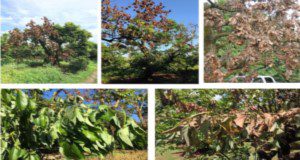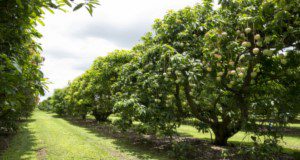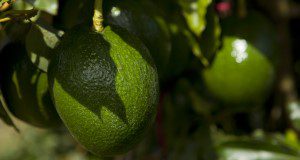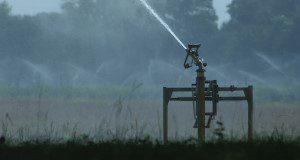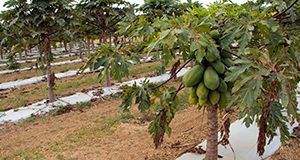Laurel wilt (LW) is a vascular disease caused by a fungal pathogen transmitted to avocado trees by several ambrosia beetle species and through root grafts among adjacent avocado trees. A critical part of preventing and controlling plant diseases is determining the causal agent so that the appropriate management practices can be implemented to eradicate or contain the outbreak. Proper sampling is a critical step in disease diagnosis and in the determination of the causal agent of disease. This new 3-page publication of the UF/IFAS Horticultural Sciences Department was written by Jonathan Crane, Romina Gazis, Jeff Wasielewski, Daniel Carrillo, Bruce Schaffer, Fredy Ballen, and Edward Evans.
https://edis.ifas.ufl.edu/hs1394
Tag: Fredy Ballen
Programacion de Riego Basado en el Metodo de Evapotranspiracion Para Papaya (Carica papaya) en Florida
La papaya es un importante cultivo frutícola que se cultiva en el sur de Florida con un área estimada de 356 acres. Este documento se centra en las técnicas de programación de riego basadas en ET para la papaya en las condiciones de Florida. Written by Haimanote K. Bayabil, Jonathan H. Crane, Kati W. Migliaccio, Yuncong Li, Fredy Ballen, and Sandra Guzmán, and published by the UF/IFAS Department of Agricultural and Biological Engineering, November 2020.
https://edis.ifas.ufl.edu/ae547
Planning for a Successful Commercial Subtropical/Tropical Fruit Grove
Planning is the key to successful grove establishment, maintenance, and production. Developing a detailed infrastructure description and plan, cultural program, and financial and marketing plan for a new or existing grove with a new fruit crop will save you time and money and help minimize mistakes. Prospective growers should compile and analyze information needed to select a grove site, establish the needed infrastructure, and develop maintenance plans for the plants and how the production will be marketed. This new 15-page publication of the UF/IFAS Horticultural Sciences Department presents an outline of the type of information growers need when establishing a tropical fruit grove or contemplating management or modification of an existing grove. Written by Jonathan Crane, Yuncong Li, Edward Evans, Fredy Ballen, and Jeff Wasielewski.
https://edis.ifas.ufl.edu/hs1387
Recomendaciones para la Detección y Mitigación de la Marchitez del Laurel en Árboles de Aguacates y Especies Relacionadas en Jardines y Patios Hogareños
This is the Spanish translation of HS1358, Recommendations for the Detection and Mitigation of Laurel Wilt Disease in Avocado and Related Tree Species in the Home Landscape. Avocado trees are a popular choice for homeowners in Florida, with over 600,000 growing in Florida home landscapes. However, avocado trees as well as others in the Lauraceae family are susceptible to laurel wilt disease, which can kill a tree in as few as three weeks. This new 8-page publication of the UF/IFAS Horticultural Sciences Department provides home owners recommendations for identifying and mitigating laurel wilt disease in the home landscape. Written by Jonathan H. Crane, Jeff Wasielewski, Daniel Carrillo, Romina Gazis, Bruce Schaffer, Fredy Ballen, and Edwards Evans.
https://edis.ifas.ufl.edu/hs1384
Irrigation System Descriptions for Tropical and Subtropical Fruit Crops in Florida
Florida’s tropical and subtropical fruit crop industries use various irrigation systems, including high-volume systems designed for irrigation and freeze protection, drip systems for herbaceous fruit crops (papaya, banana), and microsprinkler types, mainly for irrigation and fertigation. There continues to be a steady stream of potential tropical and subtropical fruit producers in Florida, many with little to no knowledge of the various types or purposes of various irrigation system that have been used successfully for the past 60 years. This new 9-page publication of the UF/IFAS Horticultural Sciences Department includes potential producers, Extension faculty and agents, and irrigation companies. Written by Jonathan Crane, Haimanote Bayabil, Edward A. Evans, and Fredy Ballen.
https://edis.ifas.ufl.edu/hs1375
ET-Based Irrigation Scheduling for Papaya (Carica papaya) in Florida
Three irrigation scheduling methods (set schedule, ET-based, and tensiometer-based) were tested for papaya production in south Florida. ET-based irrigation scheduling was found to conserve water effectively. This 6-page document primarily focuses on the ET-based irrigation scheduling techniques for papaya under Florida conditions. Written by Haimanote K. Bayabil, Jonathan H. Crane, Kati W. Migliaccio, Yuncong Li, and Fredy Ballen, and published by the UF/IFAS Department of Agricultural and Biological Engineering, March 2020.
https://edis.ifas.ufl.edu/ae540
Recommendations for the Detection and Mitigation of Laurel Wilt Disease in Avocado and Related Tree Species in the Home Landscape
Avocado trees are a popular choice for homeowners in Florida, with over 600,000 growing in Florida home landscapes. However, avocado trees as well as others in the Lauraceae family are susceptible to laurel wilt disease, which can kill a tree in as few as three weeks. This new 7-page publication of the UF/IFAS Horticultural Sciences Department provides home owners recommendations for identifying and mitigating laurel wilt disease in the home landscape. Written by Jonathan H. Crane, Jeff Wasielewski, Daniel Carrillo, Romina Gazis, Bruce Schaffer, Fredy Ballen, and Edwards Evans.
https://edis.ifas.ufl.edu/hs1358
